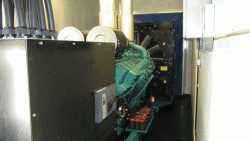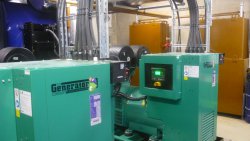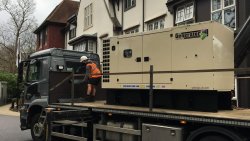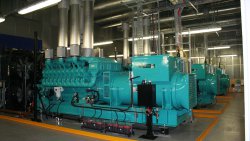165kVA New Backup Generator Installation for Royal Courts of Justice in West London
A regular Facilities Management client of The Generator Company made contact at the end of 2015 for the provision of new backup generator installations for several Royal Courts of Justice across the London area, which we were only too happy to provide.
Following several site visits and 3 proposals later we were asked to put together a mutually agreeable schedule of works in 2016 for the rip out of an old generator and the installation of our proposed new standby generator at the West London location for an 8 storey Central Family Court.
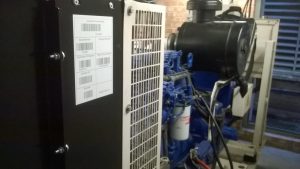 The court’s current backup power solution was incredibly old and had been deemed unsuitable for purpose. It required removing and replacing with the new set before it became ineffective in providing the court with sufficient backup power in the event of a mains outage.
The court’s current backup power solution was incredibly old and had been deemed unsuitable for purpose. It required removing and replacing with the new set before it became ineffective in providing the court with sufficient backup power in the event of a mains outage.
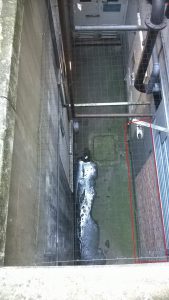 The project was straight forward, although limited on space, our proposal consisted of replacing like for like, which involved stripping down and removing their old Perkins 165kVA set and replacing it with a bespoke built automatic mains failure diesel powered Volvo 165kVA new backup generator. We also specified a new set mounted generator control panel comprising a DSE 7310 module to enable the client to monitor an extensive number of engine parameters, display warnings, shutdown and engine status information as well as providing a manual operation facility. During our previous site visits we had also ascertained suitable and functioning existing equipment that could be utilised and incorporated into the new backup generator installation.
The project was straight forward, although limited on space, our proposal consisted of replacing like for like, which involved stripping down and removing their old Perkins 165kVA set and replacing it with a bespoke built automatic mains failure diesel powered Volvo 165kVA new backup generator. We also specified a new set mounted generator control panel comprising a DSE 7310 module to enable the client to monitor an extensive number of engine parameters, display warnings, shutdown and engine status information as well as providing a manual operation facility. During our previous site visits we had also ascertained suitable and functioning existing equipment that could be utilised and incorporated into the new backup generator installation.
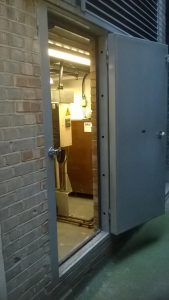 Once our schedule of works were agreed and signed off by our client we needed to prepare the site to enable us to commence with the breakdown and removal of the old set and existing redundant equipment. Its removal required intricate planning from ground level, firstly over 5m of fence and then manoeuvring via a very narrow passageway 2 storeys below. The tightness of the passageway and the width of the doorframe for entry to the plantroom was not wide enough to rotate either generator out or into the plant room and therefore the plantroom’s brick wall, doorframe and louvre had to be dismantled and taken away in order to commence with the project.
Once our schedule of works were agreed and signed off by our client we needed to prepare the site to enable us to commence with the breakdown and removal of the old set and existing redundant equipment. Its removal required intricate planning from ground level, firstly over 5m of fence and then manoeuvring via a very narrow passageway 2 storeys below. The tightness of the passageway and the width of the doorframe for entry to the plantroom was not wide enough to rotate either generator out or into the plant room and therefore the plantroom’s brick wall, doorframe and louvre had to be dismantled and taken away in order to commence with the project.
Whilst the site was prepared for the new installation the existing generator’s fuel lines, pipework, cabling, etc., to existing facilities were disconnected. The crane was readied into the small courtyard next to the fencing above the passageway to the plantroom 2 storeys below. Fastidiously, once stripped, all the required components of the old generator system were removed; the silencer, alternator, radiator and then finally the generator’s engine. Each component was jiggled and skated into the lifting position and then craned out onto our transportation ready for disposal. Once complete the reverse was carried out with the new backup generator and associated equipment. As part of the new scheme we put in a new mild steel exhaust system designed to achieve noise levels of 75 dBA at a 900 axis, 1 metre from the discharge point in free field non-reverberant conditions. The site’s existing bulk tank was suitable for re-use so it remained and once all the new plant was positioned into the designated and pre-proposed locations it was re-built and connected up to the site’s existing facilities, services and interfaces.
The removal of old and the installation of the new backup generator was carried out in just one day and once this was complete commissioning of the system could take place. Prior to the commissioning to prove the specification of the new installation the wall of the plantroom was re-built and the door frame, door and louvre were re-installed.
 During a Saturday at the arranged dedicated time slot we carried out the commissioning of the new backup generator system in the presence of the client to prove its operational performance against system design specifications. The entire new system and its integration with existing systems, automation, control systems, electrical distribution and interface equipment required fully testing before it could be taken on-line and made live. Our usual standard test procedures were carried out based on the ISO8528-6; standard observations and functional checks were undertaken with the client which was then followed by our engineers carrying out a 3 hour commissioning loadbank test with 25% power load step ups every 15 minutes up to 100% load, followed by 2 hours at 100% and then the last hour at 110% load.
During a Saturday at the arranged dedicated time slot we carried out the commissioning of the new backup generator system in the presence of the client to prove its operational performance against system design specifications. The entire new system and its integration with existing systems, automation, control systems, electrical distribution and interface equipment required fully testing before it could be taken on-line and made live. Our usual standard test procedures were carried out based on the ISO8528-6; standard observations and functional checks were undertaken with the client which was then followed by our engineers carrying out a 3 hour commissioning loadbank test with 25% power load step ups every 15 minutes up to 100% load, followed by 2 hours at 100% and then the last hour at 110% load.
On completion of the successful commissioning and a very satisfied client, the new backup generator system went live and fully operational.
